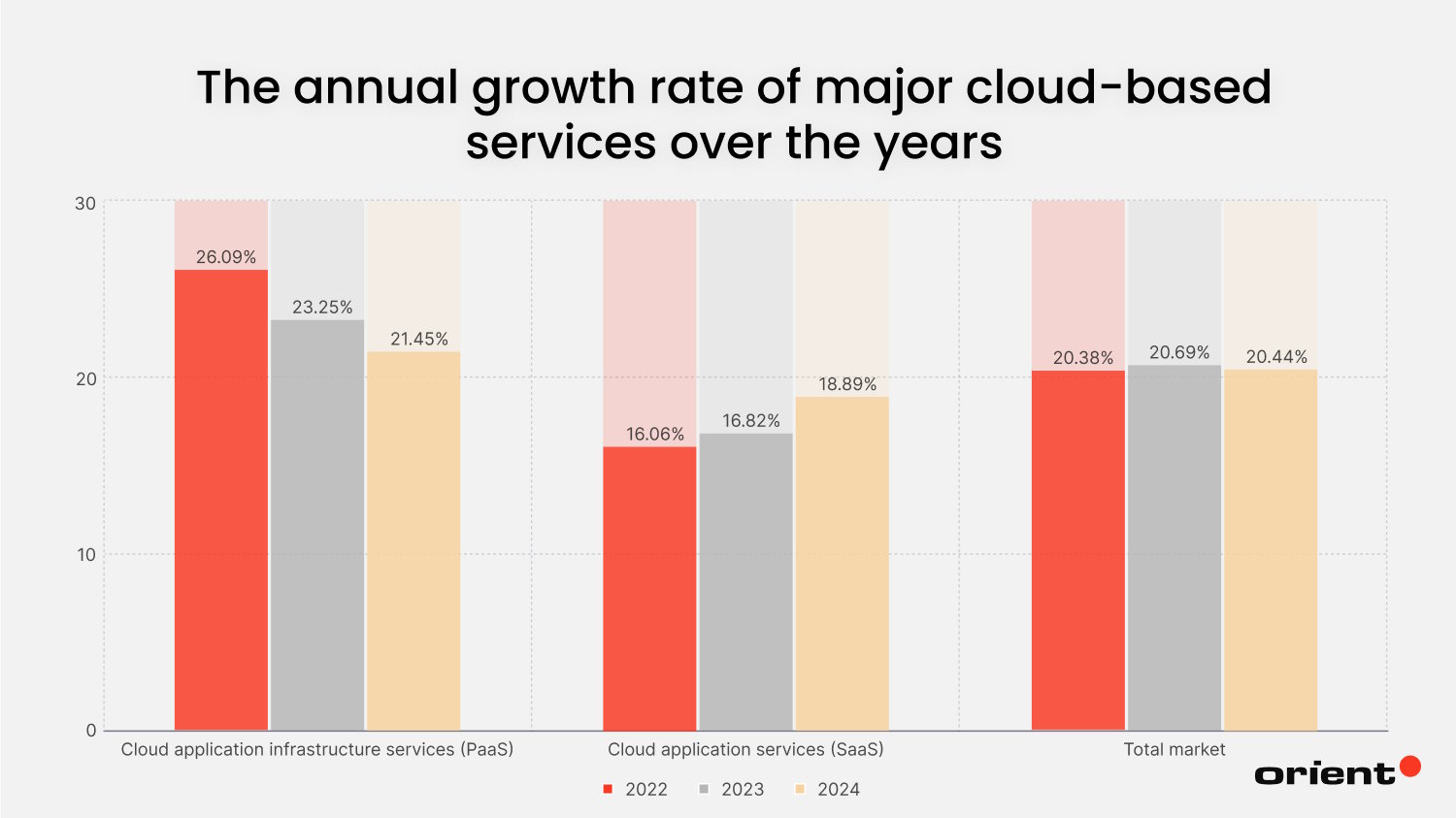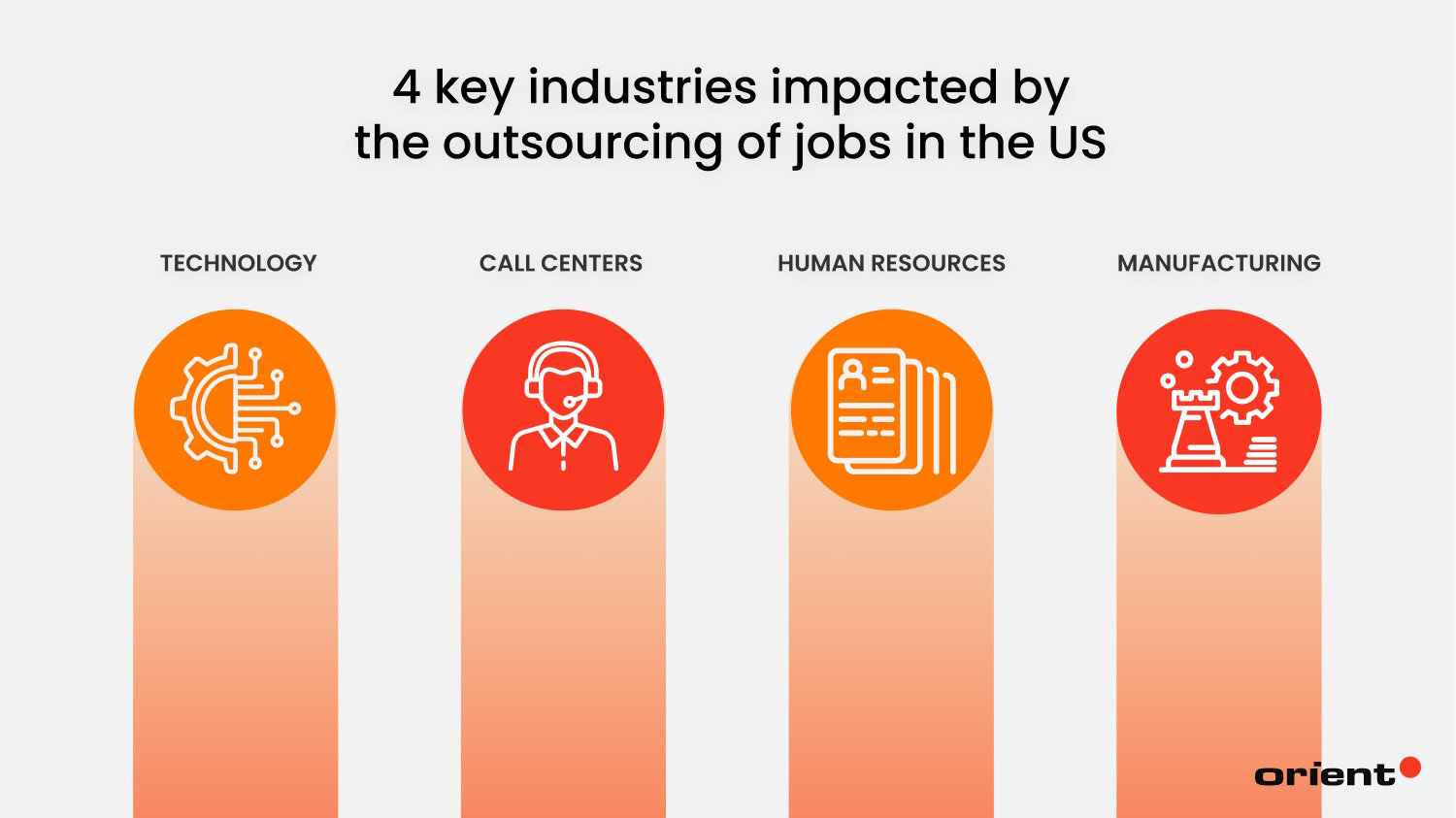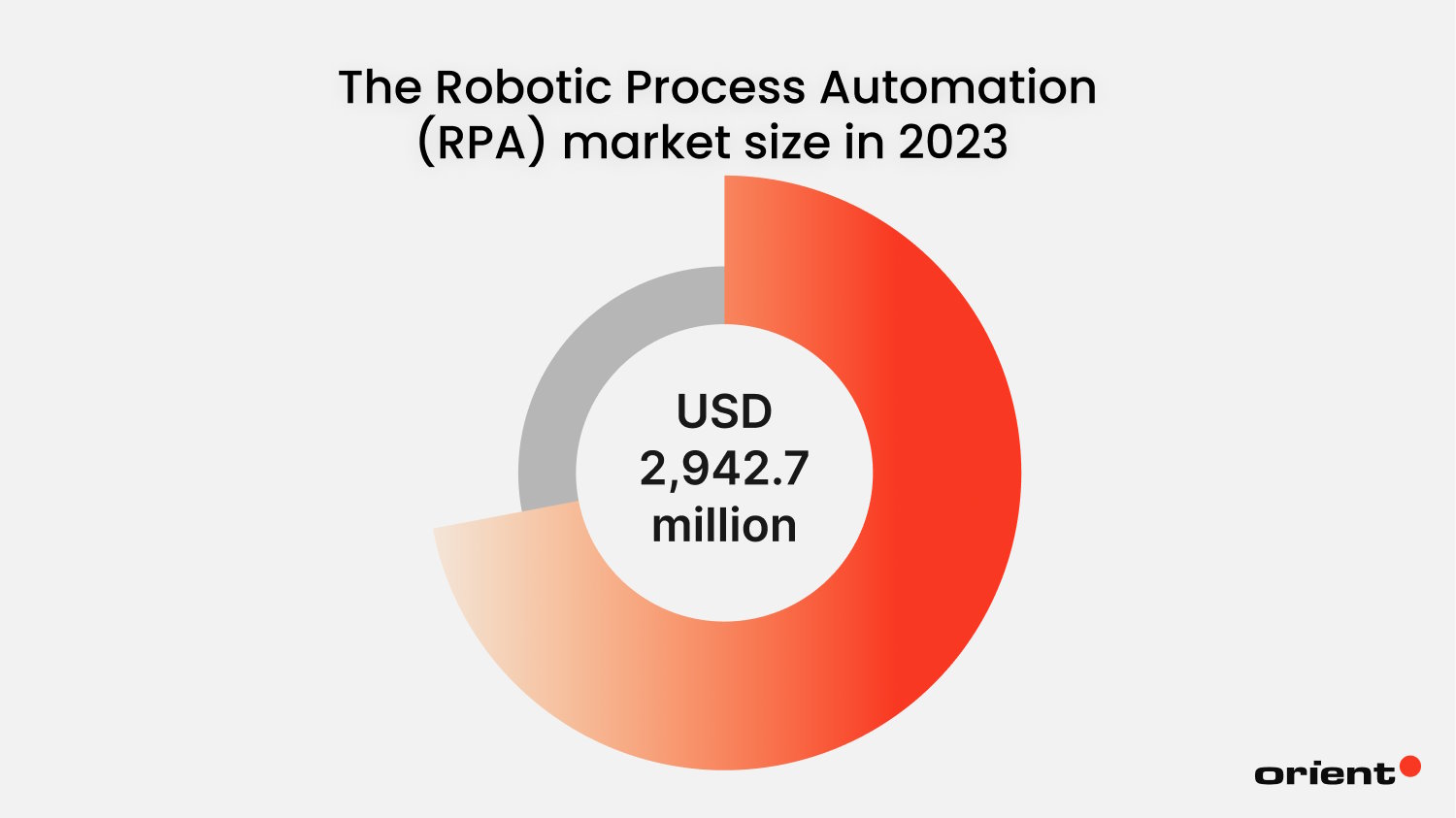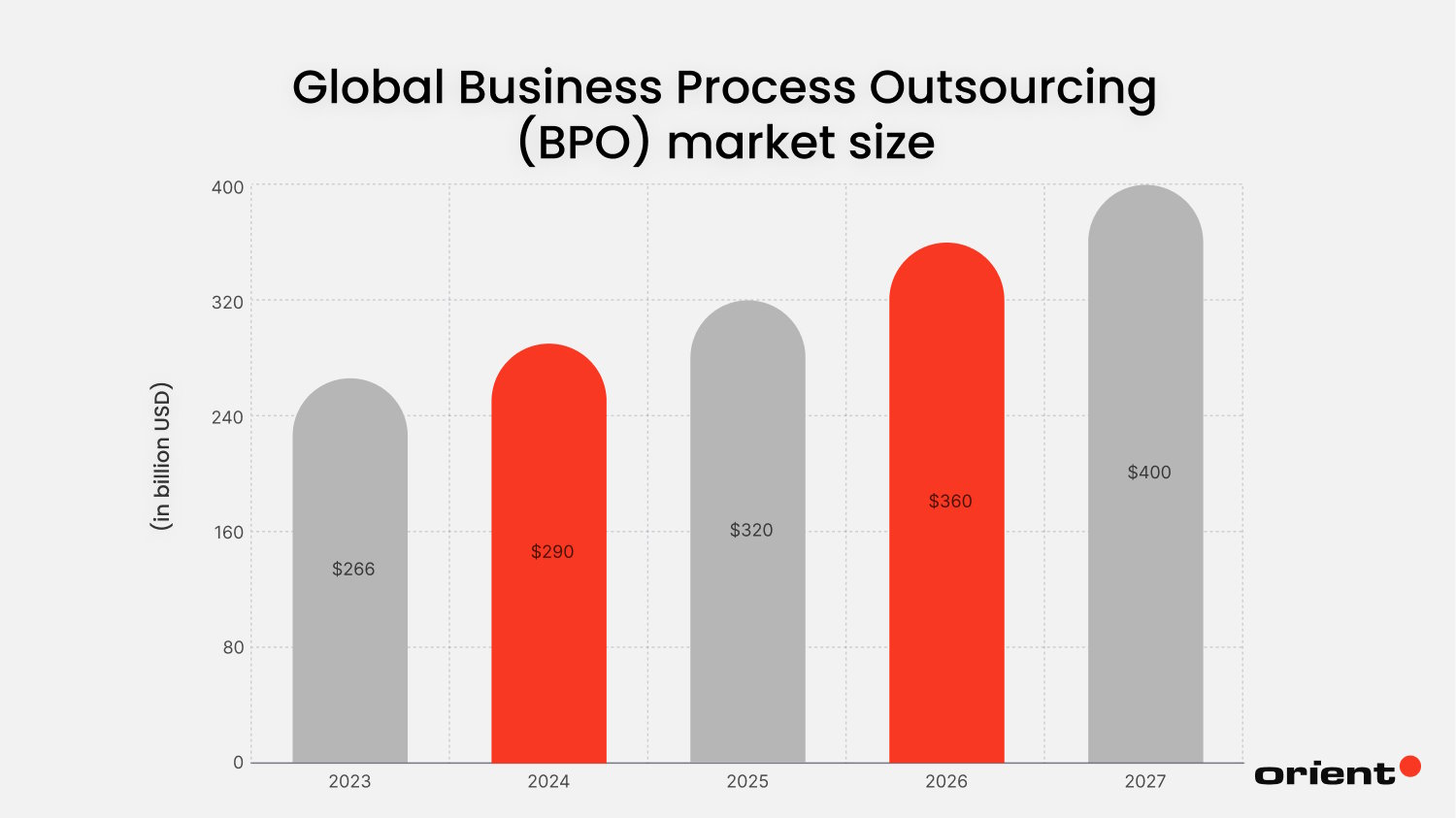The 20 Most Interesting Outsourcing Facts & Statistics
Statistics never lie, and it can provide various interesting insights. If outsourcing some parts of your internal functions is your urgent need, don’t miss these top facts and statistics to improve your decision-making journey.

Content Map
More chaptersOutsourcing is one of the best methods for businesses to locate top talent at an affordable rate. With competition thriving, companies need to work hard and implement effective strategies to stay on top. Hiring an outsourced team can surprisingly save your industry a lot of money and, at the same time, get your quality work done.
If you are looking into outsourcing, you need to do some research to understand that there is more to this sector than meets the eye. Thus, in today’s article, we will cover some of the most interesting outsourcing facts over the last couple of years and for the future.
Top Outsourcing Statistics
Even though global IT outsourcing revenue was unstable in the past, nowadays, the market seems to be stabilizing with many impressive figures. Here are some interesting large and small business outsourcing statistics that you may look for:
1. More than 90% of organizations are improving IT outsourcing by adopting cloud services.
User data collected from IoT sensors is increasing, making traditional information storage and management methods gradually become outdated and ineffective. That’s why many businesses, including outsourcing service providers, strive to switch to the modern cloud-first model.
90% of companies view cloud computing as a crucial factor in their outsourcing efforts. Until now, cloud computing is still evolving at a rapid pace due to the considerable changes it brings to businesses. It involves a network of servers hosted remotely on the internet that stores, manages, and processes a firm’s data. By leveraging cloud infrastructure, companies can enhance collaboration, streamline processes, access advanced technologies, and save hardware costs and the expense of running a data center.
Based on statistics from Statista, the annual growth rate of major cloud-based services has the following chart:

2. Most organizations partner with cloud providers to better ensure data security.

The benefits of businesses moving to the cloud are overwhelming, from increased efficiency and reduced costs. However, it is not risk-free. Cyber attacks are on the rise, and cloud computing exposes businesses to these attacks.
Data breaches are accelerating swiftly due to hackers teaming up to form groups that seek monetary gains. They may be disgruntled employees, cryptocurrency miners hijacking computers, or even nation-state hackers that are politically motivated. If an enterprise is looking to benefit from the cloud technology, and at the same time, staying safe from all kinds of vulnerability, investing heavily in security is a must.
However, many organizations do not have enough workforce to run a cloud security team. There are plenty of tasks, such as checking automated threat alerts that come in through cloud security platforms. Help from reputable cloud providers solves most of this problem when there is a lot of experience and tools needed to serve the process of storing and managing data information.
According to results from the Google Cloud Brand Pulse Survey, strong capabilities for protecting and controlling client data (40%) and good coordination with security vendors and existing security solutions (38%) are the top ways cloud providers can gain trust in enterprise cloud decision makers.
3. Around 30 million jobs are vulnerable to outsourcing.
Job outsourcing helps US businesses keep up with the fierce competition in the global market by enabling them to sell their products in foreign markets through their overseas branches. However, instead of hiring employees from the US as well to serve operations, business owners in this country are aiming for a more affordable talent pool in emerging markets.
With lower standards of living, countries in Southeast Asia, Vietnam, for example, are always the ideal destination for businesses seeking a workforce with reasonable prices yet ensuring quality. The lower wages and operating costs, combined with the simpler administrative requirements in such regions, make operating much cheaper and easier.
It is estimated that around 30 million jobs are vulnerable to outsourcing. The four primary industries impacted by the outsourcing of jobs in the US are:
- Technology – IT jobs are mainly sent to China and India because the wages are much lower and the skills are similar.
- Call centers – These jobs seem to be coming up since wages in India are catching up to those in the United States.
- Human resources - Outsourcing human resources jobs helps reduce health benefit plans, workers compensation insurance, and retirement plans by pooling thousands of businesses.
- Manufacturing

In 2015, there were more than 15 million outsourced jobs in the US, which is more than double the number of unemployed Americans. As outsourcing spending is increasing, this number tends not to stop and has the potential to negatively affect the labor market in the US. Without new jobs being created in the US, the unemployment rate rises as a norm, forcing the government to come up with quick corrective measures to get the labor market back on track.
4. More than 94% of organizations use some form of IT outsourcing.
Outsourcing IT-related business processes is one of the best strategic ways to handle tasks that are traditionally handled by internal staff. Surprisingly, even IT companies outsource some of their services. There are lots of innovative IT outsourcing companies all around the world that can ensure the best use of technology for both small and big IT businesses.
According to a Statista report, the IT market size amounted to slightly more than $120 billion in 2019, with the IT outsourcing industry valued at $92.5 billion. It can be seen that global outsourcing contract values (ISG) were made up mainly based on positive data from IT services. Experts predict that revenue in the IT outsourcing market will reach US$541.10bn by the end of 2024.
Technology is evolving rapidly, and companies need to keep up with the competition by optimizing internal processes. The IT outsourcing industry’s future looks bright, with a diverse range of opportunities. There is eventually going to be a growth in strategic partnerships between IT outsourcing companies and businesses with much focus on outcomes.
5. Manufacturers outsource an average of 70% to 80% of their finished products.
The need to cut labor costs has pushed even manufacturing companies to outsource some manufacturing processes by hiring outside your company to assemble parts or build an entire product. China is an example of one of the regions with the lowest cost of manufacturing, where most manufacturing companies, entrepreneurs, and retailers outsource their services.
Business owners need to evaluate the costs required for internal processes before making an outsourcing decision. A company struggling with redundant activities or processes might experience little to no profitable growth.
Before choosing any company to satisfy your needs, it is essential to look into key suppliers, focus on the best services before prices, and outsource to a company with almost similar business philosophies and management styles.
6. Many companies are seeking to automate their processes with Robotic Process Automation (RPA).
While the Robotic Process Automation (RPA) market size was valued at USD 2,942.7 million in 2023, the industry is predicted to continue its strong growth momentum which exceeds USD 8,781.2 million by 2026 growing at a CAGR of 29.5%.
The rapid rise of robotic process automation after the COVID-19 pandemic is rumored to lead to the death of business process outsourcing. It is natural to wonder if robots will soon be taking over the work, so many companies currently outsource their workload to BPO firms. RPA uses rule-based algorithms to automate specified processes on enterprise software and mainframe systems.

However, this evolution will look more like many evolutions in technology we have had before. Many inside the RPA industry see this as an opportunity rather than a threat to global business process outsourcing (BPO). Automation of processes in an organization is mainly beneficial to business owners. Still, this technology benefits employees in the following ways:
- Employees get to focus on more complex tasks or involve themselves in new projects by reducing repetitive and tedious tasks that slow them down.
- Improved accuracy through the elimination of errors that may be unavoidable in manual performance.
- Improving and simplifying processes.
- RPAs can work 24/7, hence increasing the quantity and speed of work.
7. India still leads in global outsourcing.
India has long been the preferred choice for offshoring and outsourcing, especially for English-language operations. It has proven to be the most mature market for service outsourcing, with a history of data processing, data entry, virtualization, and other top-skilled services.
More than 59% of businesses globally are already outsourcing some form of service in India. The most common forms of outsourcing relate to IT or BPO (Business Process Outsourcing). Technical support teams, software developers, and infrastructure are highly sought after. Their services are much cheaper and as effective and valuable as employing a local group.
The talent pool in India is highly qualified to respond to the needs of the IT/ITeS industry as well as other fields. There is no limitation caused by language barrier since the country has over 100 million English speaking people, the second largest after the USA. Every year, there are more than 150,000 engineering graduates that join the IT industry, and this ensures unlimited availability of services.
However, due to global uncertainty in demand, outsourcing providers in India have at times delayed recruiting more information technology personnel and instead used existing developers to optimize financial strategies.
Within the Asia region, Malaysia, the Philippines, and Vietnam are also upping their IT and IT services outsourcing game, giving tough competition to India as their costs are at times on a par.
| Country | Average Annual Salary (USD) |
|---|---|
| China | $57,000 |
| Japan | $52,000 |
| Vietnam | $17,000 |
| India | $11,000 |
| Israel | $70,000 |
| Philippines | $10,000 |
| Singapore | $55,000 |
| Taiwan | $42,000 |
| Malaysia | $13,000 |
8. More than 40% of help desk positions in the banking industry are outsourced.
Help desk services require providing consumers with impeccable technical support in their time of need. Some organizations’ budget does not allow an internal help desk solution to support customers. It is the main reason why help desk outsourcing is considered as a solution.
55% of customers are likely to get attracted to excellent customer service, with 85% ready to pay more for an upgraded help desk experience. It shows how important it is to provide satisfying customer support services.
In 2021, more than 40% of banking and financial institutions partnered with outsourcing service providers to support desk employment activities. Organizations enjoy several mind-blowing benefits from help desk outsourcing, which includes:
- Internal support teams can be very effective, but such teams can’t provide 24/7 help desk support. Outsourcing offers a team of experts working in different shifts.
- Internal support staff may lack the experience to bring all calls to a resolution. Outsourcing gives you experts with better call management skills who deliver excellent solutions to your customers.
- With the latest technologies, it has become easier to cut down response time by immediate dispatch.
- Outsourcing help desk services reduce costs of labor, technologies, tools, and customer losses.
9. Freelancers represent 38% of the US workforce in 2023
Forbes research shows that the current representation of freelancers within the workforce is between 35% and 40%. Additionally, according to a 2023 study from Upwork Research Institute, up to 38% of the US workforce did freelance work last year, contributing almost $1.3 trillion in annual earnings to the US economy.
The recent numbers in the freelancing world emphasize a spike in revenue. The reason for this is that freelancing is more appealing to employees that prefer a flexible working schedule with more freedom for creativity.
Working on specific projects they like and setting their hours not only gives them freedom but also the time and ability to maximize their skills and provide outstanding services. Outsourcing freelancers is very common because of the quality of work they produce. Since competition among them is also high, it is possible to get the right freelancer at a very affordable rate on various existing freelancing platforms.
10. Business Process Outsourcing (BPO) is expected to hit over $400 billion by 2027.
Today, industries such as health, e-commerce, tech, and many others rely on BPOs to help streamline their internal processes. Most BPO activities that get contracted externally are in-house business functions such as human resources or front office needs. Both big and small companies, about 59%, are gradually embracing outsourcing as a tool for cost savings. In return, the BPO industry continues to grow immensely.

BPO business analytics provides the forecast for the current and expected industry trends. This data comes from observation, evaluation, and analysis of current business trends, technologies, and other essential factors that impact the industry’s revenue.
Even as technology continues to get rid of some business opportunities through automation, new jobs are being needed. The IT industry, which is the most outsourced industry, requires employees and freelancers to keep up to date with the current trends in technology to provide high-quality services. Partnerships between companies and outsourcing companies, both locally and internationally, are also on the rise.
The global outsourcing market is expected to provide employment opportunities to millions of individuals in the coming years. More jobs are being transformed to follow the technology advances, hence, it is a high time for people to adopt the trend of remote contract work and employment.
More Interesting Outsourcing Statistics
11. The global revenue from IT outsourcing is projected to reach a new peak in 2029 after the ninth consecutive year of increase. (Statista)
12. 70% of B2B decision-makers handed off key services to third parties, while 25% say they’ve never done so in any area of their organization. (YouGov)
13. In 2022, the market size of the Chinese service outsourcing industry reached approximately 252 billion US dollars, representing an annual growth of 11.4%. (Statista)
14. Sales of BPO services in Japan are expected to exceed 5.3 trillion yen by fiscal 2027. (Statista)
15. Small businesses are more likely to outsource payroll services than larger organizations. (Statista)
16. Freelancers contributed $1.3 trillion to the US economy in annual earnings, up $100 million from 2020. (Upwork)
17. IT outsourcing developer salaries from Eastern Europe are 10-50% higher than those in Southeast Asia. (Business Today)
18. 59% of businesses cite cost efficiency as the primary reason for outsourcing. (Zippia)
19. In a survey conducted in 2022, up to 47% of marketing professionals outsourced graphic design. (Statista)
20. The global payroll outsourcing market is projected to reach $19.5 billion by 2031, with a CAGR of 7.2% from 2022 to 2031. (Allied Market Research)







